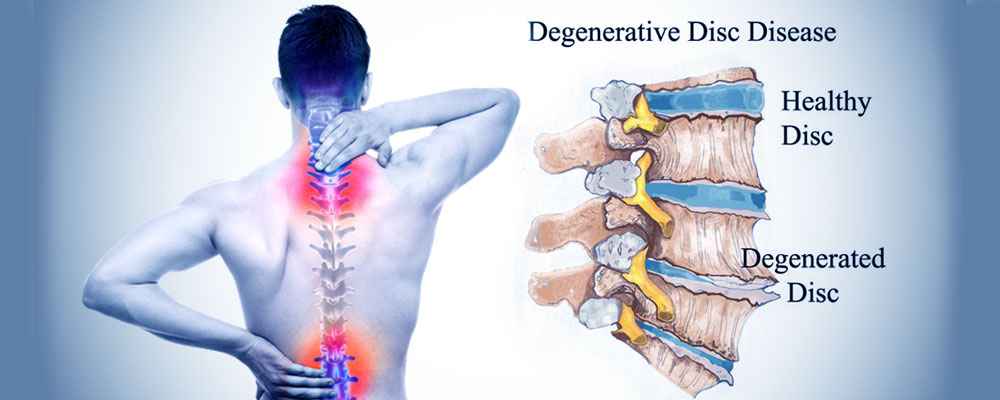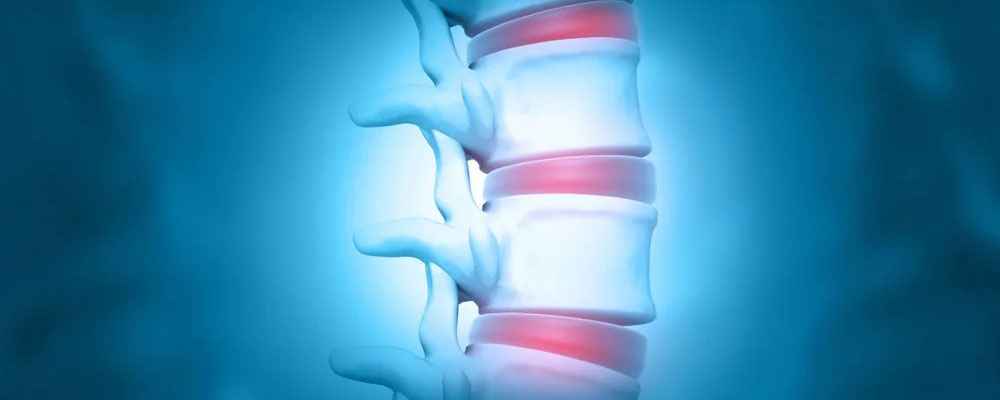Degenerative disc disease is a condition in which the cushioning in your spine begins to wear away. Generally, this disease occurs in the elders. People are susceptible to spinal degeneration after age of 40. Pain alleviation and better mobility can be achieved with the correct therapy.
Degenerative disc disease is a condition in which spinal discs wear out. Spinal discs are rubbery cushions that sit between your vertebrae (the bones that make up your spinal column). They act as shock absorbers, making it easier to move, bend, and twist. Generally spinal discs degrade with time, it is a part of the ageing process.

When the cushions wear out, the bones might begin to rub against each other. This touch can result in discomfort and other issues, such as:
Even if they don't have symptoms, almost everyone has some degree of disc degeneration beyond the age of 40. For roughly 5% of people, it can cause back discomfort.
The most prevalent age group for degenerative disc disease is the elderly. Some risk factors for developing degenerative disc disease include:
Neck and back discomfort are the most prevalent symptoms of degenerative disc degeneration. You could feel discomfort because:
Spinal discs degrade naturally as we age. Most people have some disc degeneration, especially after the age of 40. However, not everyone feels pain.
You may have discomfort if your spinal discs:
Dry out: The soft core of your discs is largely water. It generally causes that core to lose some water as you age. As a result, discs become thinner and no longer absorb as much stress as they once did.
Minor injuries might result in minor fissures in your spinal discs. These rips are frequently found near nerves. Even tiny tears might cause discomfort. If the outer wall of your spinal disc cracks open, your disc may bulge out of position, causing a spinal nerve to be compressed.
Your healthcare professional may begin by asking you about your symptoms in order to identify degenerative disc disease. Questions could include:

Imaging scans such as X-rays, CTs, or MRIs may be suggested your healthcare professional. These tests can show your doctor the condition and alignment of your discs.
Non-invasive treatment methods are usually recommended initially by your healthcare physician. Your therapy may involve the following:
Participating in strengthening and stretching activities with a skilled healthcare therapist is known as physical therapy.
Medications include the use of nonsteroidal anti-inflammatory medications (NSAIDs), muscle relaxants, and steroids.
Injections of steroids near your spinal nerves, discs, or joints to decrease inflammation and discomfort.
Radiofrequency neurotomy is a procedure that involves using electric currents to burn sensory nerves and prevent pain signals from reaching the brain.
Lifestyle adjustments can help to prevent or decrease the course of spinal degeneration. Some examples are:
Degenerative disc disease develops when the spinal discs deteriorate. People often feel back pain and stiffness as these discs wear out. Nonsurgical therapies, such as physical therapy and spinal injections, may provide pain relief. Home treatments such as heat and cold therapy might help some individuals relieve discomfort. If your discomfort is severe, spinal injections or spine surgery may be beneficial. A spine expert, Dr. Ravi Suman, can advise you on the best treatment option for you.
Dr. Ravi Suman specialises in non-surgical, zero-downtime therapies that represent the most recent advances in medical care. Dr. Suman has become a beacon of competence in offering cutting-edge remedies for many ailments without the need for intrusive operations, with an emphasis on pioneering approaches such as Platelet-Rich Plasma (PRP) Therapy. These novel medicines promise patients excellent comfort with minimal disturbance to their everyday lives. Dr. Suman's devotion to non-surgical treatments demonstrates his commitment to providing patients with the most modern and least intrusive options available, ensuring optimal outcomes and a quick return to a happy, pain-free existence. His mastery of these cutting-edge, no-downtime therapies cements his position as a pioneer in providing progressive, patient-centred care in the field of non-surgical procedures.
Age, traumatic injury, obesity, heavy lifting, contact sports and repetitive motions are some of the risk factors of DDD.
The doctor will perform a physical examination. DDD can be diagnosed through bone scan, discogram and myelogram. An X-ray or CT scan can also be performed to detect DDD.
Try to sit on an ergonomically designed chair to reduce strain on the lower back. Sit in an upright position, don’t slump as a bent posture might exert excess strain on the lower back.
People with DDD are advised to sleep on their back. Pillows can be used below knees and lower back for additional support.